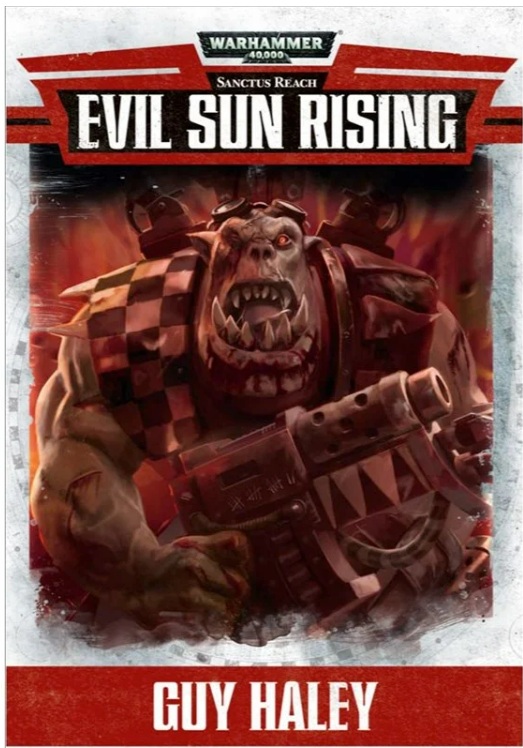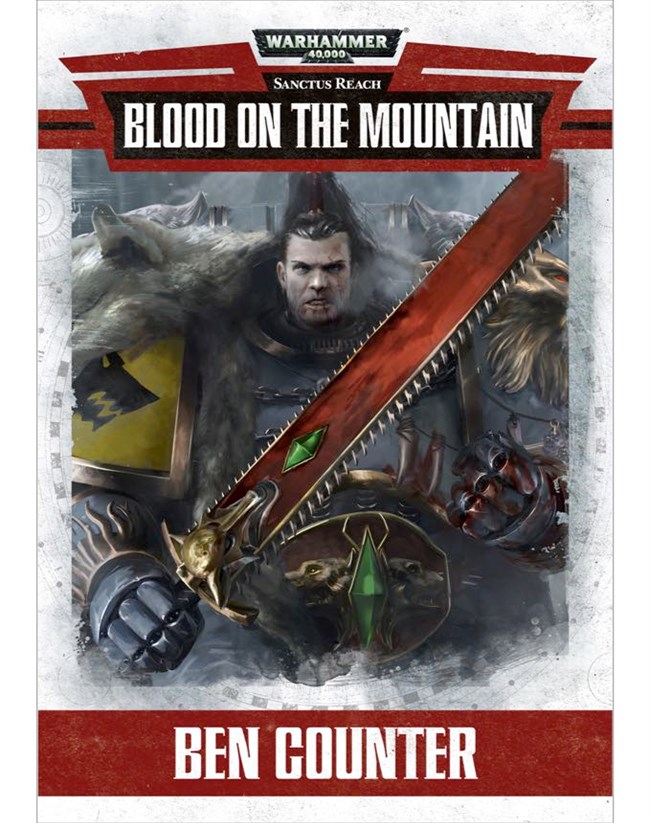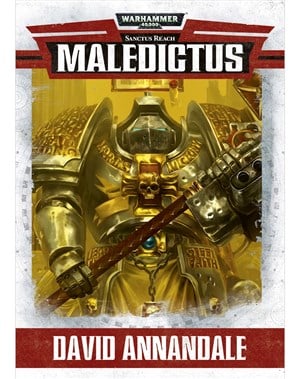The Sanctus Reach campaign represented something of a full-court press from Games Workshop a decade or so ago. As we covered in our recent Lore Explainer, the 7th Edition of Warhammer 40,000 brought with it a renewed emphasis on narrative play and regular campaign supplement releases.
Not only that, but video gamers could scratch the itch with a Sanctus Reach turn-based tactics game that dropped about three years later, which we also reviewed here. Of course, what is narrative play without a narrative? Another front on the battlefields of the imagination was opened up with a series of stories released through the Black Library, which included several short stories and a trio of novellas.
Today we’ll be looking at those novellas which, taken together, tell three different sides of the story. It’s not quite Rashomon, with the same event being told from multiple perspectives, but rather stories that are interlinked through the common setting but otherwise aren’t directly connected.
The Black Library put this task firmly in the trio of Guy Haley, Ben Counter, and David Annandale. Of the three, Counter was the grizzled veteran, debuting in 1999 with his first novel, Soul Drinker, coming three years later. Annandale arrived on the scene only in 2011 with The Carrion Anthem, with Haley coming the year following, but both had been prolific contributors. They were certainly up to the task.
With the Orks with their Red Waaagh! playing the villain’s role in Sanctus Reach, it was only fitting to let them kick things off.

Evil Sun Rising, by Guy Haley
So let me start by saying I’m a big believer in Mark Rosewater’s adage that “if you think a card is bad, it probably wasn’t designed for you.” Pre-Goonhammer when I would post book reviews on social media, I read Marc Collins’ Eidolon: the Auric Hammer. I didn’t love it, finding the pacing too bogged down with introspective passages even in the action-y parts. Lo and behold, guess what book took runner-up for Black Library Book of the Year in 2024?
So just because I didn’t really enjoy Evil Sun Rising as much as I’d hoped, that doesn’t mean it’s a bad book. It just wasn’t the book for me.
The story involves a Stompa krew who have joined the Red Waaagh! under Krugg the Tyrant. Their leader, Big Mek Uggrim, must navigate treacherous Ork scheming and watch for a knife in their backs as they pilot Fat Mork to glory.
Much of my dissatisfaction with this story came from how the Orks were depicted. Never their biggest fan, I’ve become a bit particular when it comes to their portrayal. There’s a certain sweet spot at the juxtaposition of savage and silly that makes them a faction like no other in the grimdark far future. Too silly and they’re hard to take them seriously. Too savage, and they start to cheat into the narrative territory owned by the ‘Nids as unthinking killers.
But if you can hit that balance, they are superbly entertaining. Anyone wanting a recent crash-course on that is encouraged to check out Painboyz, the short story from Mike Brooks released as part of the Black Library Celebration’s eShort subscription which plays them to perfection. Justin Woolley also did a nice job of playing to their strengths with last year’s Da Red Gobbo Returns.
Haley’s Orks aim a little too high, almost being in the main largely indistinguishable from, say, underhive gangers. He seems to peg the needle at that particular comedic trope that juxtaposes burly ruffians with genteel speech.
For example, when the gathering of Ork Meks is welcomed by Krugg’s representative. “Welcome. Welcome, big meks of the Red Waagh!, to the Wrath of Gork, home of our master, the mighty Warlord Grukk.” He held up a finger. “I warn you, gentle-orks, before you step out, that his name is as his temper- short, and to the point.”
Another example, after taking down an Imperial Knight one Ork marvels, “a veritable treasure trove of alien technological salvage. Ain’t it pretty?”
Finally, he writes about Uggrim’s brain “brim[ming] over with inherited knowledge, some of which was so complex it would have kept the assembled priesthood of a forge world occupied for a generation or two.”
Haley’s Orks might just be a little too smart for my tastes, as I prefer the “red go fasta” variety.
Still, Haley writes some really delightful action sequences, and while Fat Mork gets held back from the action for the story’s lead-up (those Ork politics I referred to earlier), once they get unleashed on the battlefield the battles are a delight.

Blood on the Mountain, by Ben Counter
When cooking the perfect recipe, there are two crucial factors.
The first of these is having all the right ingredients, and the second is to have the ability as a cook or chef to prepare them in just the right way.
For an action story, these ingredients include having engaging protagonists up against a compelling enemy, then mixing them with dynamic fighting scenes that keep the pace of the tale moving forward. The frosting on the cake is when you can have elements of mystery or suspense that keep the reader intrigued.
Just as important is finding the right balance. Too much backstory and the pacing can drag. Too much action without enough depth, on the other hand, and you get “bolter porn.” Counter crafts like a veteran chef here, with a page-turning adventure story that never tries too hard to exceed its remit.
Blood on the Mountain is about as good an example as you can find of this in the novella form, as the smaller space acts as something of a limiter on what you can accomplish across its pages. Counter uses every page to craft a tight, focused adventure featuring a Space Wolves raid on an Ork facility on Alaric Prime that ends in a controlled retreat up a sacred mountain.
The raid on the Orks has a strong “dambusters” feel, with a small, elite strike force taking on overwhelming odds on a sabotage mission. As things start to unravel, leading to a retreat action up the mountain, the tension is terrific- all the moreso as the mystery of what is at the top of the mountain begins to unfold.
As for the story’s enemies, the Orks have the right balance of savage and ridiculously chaotic led by an Ork with an otherworldly malevolence that serves as a terrific foil. “They’re insane,” said Tannjost. “Their rank and file are,” said Ulli. “Their leader knows exactly what it is doing.”
Counter knows exactly what he’s doing and doesn’t put a foot wrong.

Maledictus, by David Annandale
If Blood on the Mountain was superbly-crafted, straightforward action yarn perfect for the novella length, Maledictus swings for the fences with a novel’s worth of content. There’s a risk there that the smaller space proves unequal to the task, resulting in a story that feels rushed but Annandale’s story absolutely sticks the landing. This is top-notch work.
Annandale’s story concerns a cadre of Grey Knights dispatched to Squire’s Rest, an agri-world in the Sanctus Reach that has largely served as a retirement world for members of the Imperial Guard. The disparity between normal Humans (let alone geriatric ones) and Astartes is easy to play for comedic effect, even unintentional humor such as in Blood Harvest, Richard Swan’s cracking story that recently saw its first paper printing in last month’s Blood of the Imperium anthology.
To his credit, Annandale not only plays these retired Guardsmen and -women completely straight but gives them their due. Yes the Orks reap them like wheat, and next to the Grey Knights they contribute little to the overall kill tally, but their honor and valor to give their all even when they have little to give finds a sympathetic note with the Knights.
As we saw most recently in another story from Blood of the Imperium, Matthew J Harffy’s The Whispering Blade, Imperial Guard don’t tend to have good outcomes when encountering the Grey Knights. Seeing a bit more of a human side from these Astartes gave the story another layer of emotional heft.
The Knights are there because their prognosticators have predicted a daemonic incursion imminent at that location, and the mysteries that wend through the book are its other great strength. Annandale is masterful here, giving the reader not one but two different enigmas to unravel- one of which threatens to erupt into open conflict between two different Inquisitorial ordos.
And therein lies the gamble. With so much narratively packed into the book, there’s a danger in trying to do too much and spreading the tale thin. If the end drags perhaps just a little bit, it’s no sin when weighted against what the author accomplished here.
As always, your mileage may vary. As a trilogy this was a bit uneven, but all the same as a time capsule for the 7th Edition’s narrative campaign this was a fun exercise. Of the three, Maledictus is the one I’d most recommend to someone even independent of the Sanctus Reach setting. It’s just a superb Warhammer story, and well worth the read.
Have any questions or feedback? Drop us a note in the comments below or email us at contact@goonhammer.com. Want articles like this linked in your inbox every Monday morning? Sign up for our newsletter. And don’t forget that you can support us on Patreon for backer rewards like early video content, Administratum access, an ad-free experience on our website and more.


